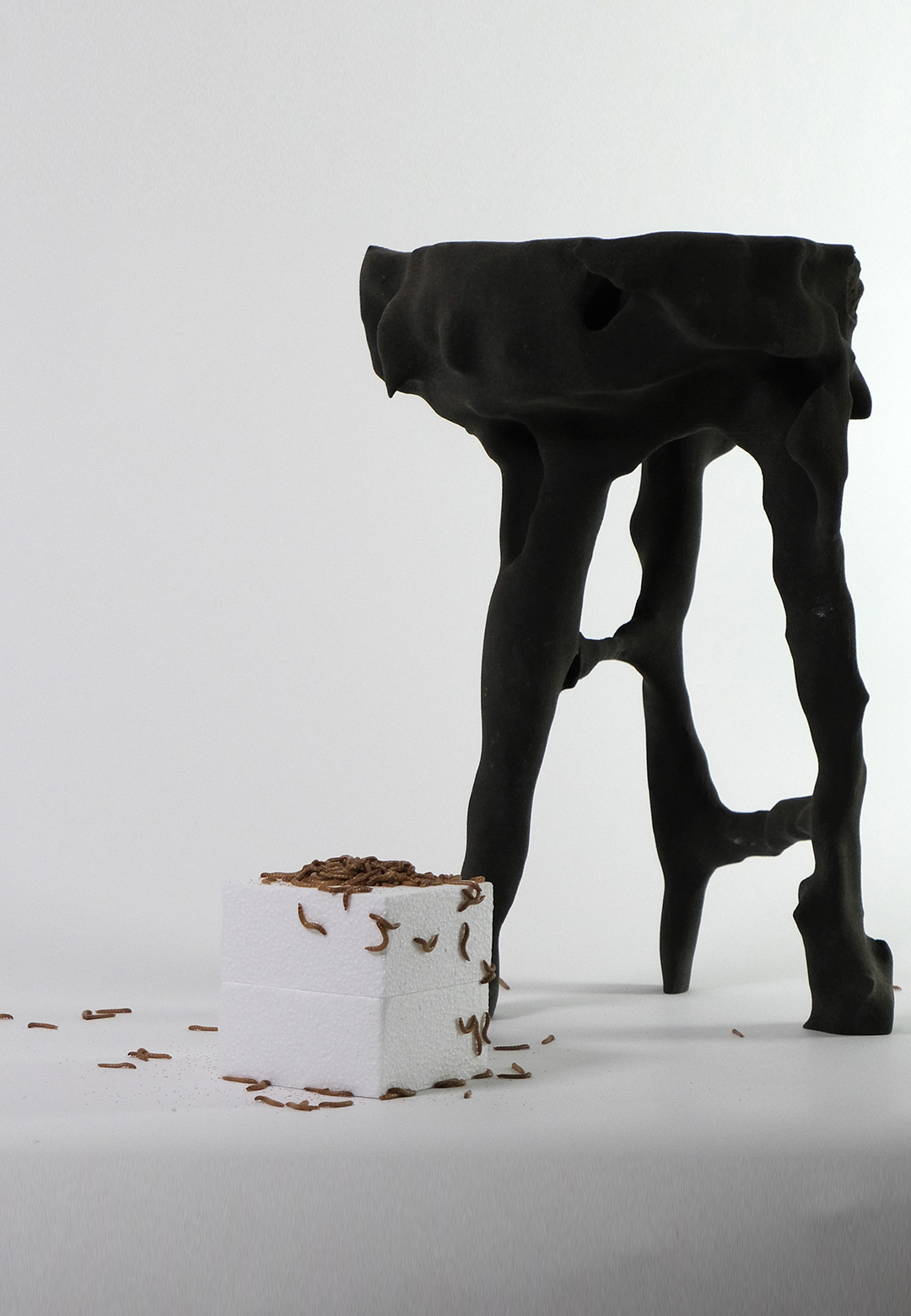Over 150 mealworms were active decision makers in the form building of British designer William Eliot’s project Digested Objects, in which the larvae subjected over waste polystyrene eat it away in paths and shape a three-legged stool-looking prototype. The project, described to have involved a bio-collaborative process in which humans and non-humans work in tandem to design objects and furniture, advocates Eliot’s message for designers to let go of their need to monopolise the design process and reflect on the importance of perceptive thinking.
As research has shown mealworms’ incredible ability to eat and safely digest plastic, Eliot sought to find a symbiotic relationship with these creatures. Instead of extracting the enzymes for the polystyrene digestion from the worms, he made use of these attributes in a creative post-human process where degeneration plays a central role. For the experiment, he injected sugar trails into waste polystyrene where a seeming scaffold was put forth before the worms. As the larvae begin eating away the plastic, some followed the trails while others deflected to burrow in the paths they like. Thus, reacting to the actions of the worms – the subtractive process offered a form and a pitted surface of the leftover polystyrene that appeared as a miniature furniture piece.
Founder of Biocrafting.Studio and a graduate of the Innovation Design Engineering course at the Royal College of Art and Imperial College, Eliot conducted several small-scale experiments to create an array of designs before a model was finalised, 3D scanned and digitally scaled-up to a full-size stool. While the prototypes were cast in jesmonite, a water-based composite material used to make decorative moulded objects, the final stool was crafted with a sustainably sourced black sand in collaboration with German company Sandhalden’s latest 3D printing techniques. Sandhalden’s binder jetting process proved to be a powerful tool in realising an organic landscape devoured by mealworms. Sand particularly stood out in mimicking the tunnelled forms on a magnified scale, with enhanced tactility and high detail.
Commenting on how the unlikely collaborators added to the efficiency of the project, Eliot says, “Mealworms are able to burrow into solid objects in organic patterns that machines are incapable of achieving. Did it add value to the larger scheme of things? Perhaps yes," as Eliot goes on to explain how “seeing insects and animals as creative partners, not just species that need to be protected, alters perceptions we have of the creatures that inhabit the planet. It opens up creative opportunities, and engages interaction and engagement in ways that go beyond charity.”
A month-long project that involved several small-scale experiments, the ensuing method put a spotlight on the elaborate mealworm tunnels that define the surface of the stool. As per Eliot, collaboration with mealworms on a project such as this work under controlled environments. “Mealworms thrive in temperatures ranging from 25 to 28 degrees Celsius with a relatively high moisture level […] Late spring and early autumn in the UK offer the best climate for collaborating with mealworms, facilitating easier temperature regulation and insulation,” he says.
With noted precedents such as Neri Oxman’s experiments with silkworms and Ren Ri’s explorations with beehives that involve additive processes, Eliot’s project stands out for its subtractive approach, an idea that has not yet been seen before. However, collaboration with mealworms raises ethical questions such as whether this relationship benefits the worms at all. Responding to this, Eliot explains that mealworms are used as a source of protein for animals, and Biocrafting.Studio is turning man-made plastics into a sustainable source of protein. “In this project, mealworms are cycled on and off polystyrene every few days and provided with an organic biowaste-based diet to cater to their needs,” he concludes.






 Sign in with email
Sign in with email










What do you think?